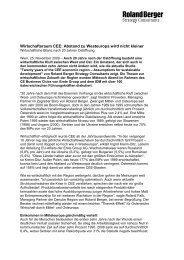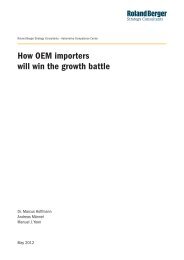Beyond cross- functional functional collaboration
Beyond cross- functional functional collaboration
Beyond cross- functional functional collaboration
You also want an ePaper? Increase the reach of your titles
YUMPU automatically turns print PDFs into web optimized ePapers that Google loves.
St Stuttgart, tt t November N b 2010<br />
<strong>Beyond</strong> <strong>cross</strong>-<br />
<strong>functional</strong><br />
<strong>collaboration</strong>
This study explores how companies can go beyond "classical",<br />
task force-based <strong>cross</strong>-<strong>functional</strong> <strong>collaboration</strong><br />
OBJECTIVES<br />
Assess the status of<br />
"classical" <strong>cross</strong><strong>functional</strong><br />
<strong>collaboration</strong><br />
Explore approaches<br />
how to successfully<br />
"go beyond"<br />
DDerive i recommendations d ti<br />
as basis for discussion<br />
and development needs<br />
METHODOLOGY AND SAMPLE<br />
• Exploratory approach based on semi-structured interviews<br />
• Approx. 20 1-2 hour interviews with senior managers<br />
• Broad spectrum of different industries, company sizes and<br />
functions:<br />
Industry Turnover [EUR bn pa] p.a.] Function<br />
Other<br />
IT & telecommunication<br />
Source: Roland Berger study "<strong>Beyond</strong> <strong>cross</strong>-<strong>functional</strong> <strong>collaboration</strong>"<br />
36%<br />
Engineered<br />
products<br />
29%<br />
14% 21%<br />
Consumer<br />
goods g<br />
0.5<br />
29%<br />
36%<br />
21% 14%<br />
>5<br />
>1<br />
Other<br />
Organization<br />
SCM<br />
26%<br />
29%<br />
14%<br />
21%<br />
14%<br />
General<br />
mgmt.<br />
Procurement<br />
2
Key insights of the study<br />
1 Functions still dominate today's corporate structures – However, increasing need to<br />
integrate a<strong>cross</strong> functions<br />
2 Companies rely on "classical" classical , task force-based <strong>cross</strong>-<strong>functional</strong> <strong>collaboration</strong> to overcome<br />
<strong>functional</strong> barriers – Its use is wide-spread<br />
3 However, "classical" <strong>cross</strong>-<strong>functional</strong> <strong>collaboration</strong> is often not successful – Insufficient<br />
incentives and fear to loose power as main reasons<br />
4 Companies need to adapt their management system to go beyond "classical" <strong>cross</strong><strong>functional</strong><br />
<strong>collaboration</strong> – 3 elements are most important<br />
A Implement alternative organizational models – Especially network structures<br />
expected to gain importance<br />
B Strengthen roles which facilitate <strong>collaboration</strong> – Especially staff to operatively drive<br />
or additionally support a project/process/task will become more important<br />
C Improve the skills of the employees to prepare them for less hierarchical/structured<br />
environments<br />
5 Many companies are prepared to implement major organizational changes – However,<br />
systematic change management is required<br />
6 Our view: Depending on the industry, network and process organizations will significantly<br />
grow in importance; companies need to look for a solution tailored to their needs<br />
Source: Roland Berger study "<strong>Beyond</strong> <strong>cross</strong>-<strong>functional</strong> <strong>collaboration</strong>"<br />
3
1<br />
Functions still dominate today's corporate structures – However,<br />
increasing need to integrate a<strong>cross</strong> functions<br />
"Functions dominate today's<br />
corporate p structures"<br />
Fully<br />
agree<br />
Fully<br />
dis-<br />
agree<br />
0%<br />
8%<br />
31%<br />
54%<br />
8%<br />
Functional<br />
specialization, silos<br />
Source: Roland Berger study "<strong>Beyond</strong> <strong>cross</strong>-<strong>functional</strong> <strong>collaboration</strong>"<br />
REQUIREMENTS<br />
FOR THE FUTURE<br />
Growing global<br />
integration<br />
Increasing customer<br />
requirements<br />
More complex p structures<br />
and processes<br />
Exhausted "<strong>functional</strong>"<br />
potentials<br />
Cross-<strong>functional</strong><br />
integration<br />
4
1 BACKUP<br />
"Today, our decision structures are mostly <strong>functional</strong>. That doesn't<br />
fit with tomorrow's requirements."<br />
Further interview quotes<br />
DOMINANCE OF FUNCTIONS<br />
"We have several organizational<br />
dimensions dimensions. But functions own the<br />
resources/budgets."<br />
"Organizations exceeding a certain size<br />
require specialized staff clustered by<br />
functions/sub-functions. That's a given."<br />
REQUIREMENTS FOR THE FUTURE<br />
"Global competitive pressure rises day<br />
by day day. An integrated view is required to<br />
tap hidden potentials."<br />
"We have mostly realized the potentials<br />
on a <strong>functional</strong> level level. Now our focus are<br />
<strong>cross</strong>-<strong>functional</strong> improvement teams."<br />
"Functions dominate more than they<br />
"Global networks especially in<br />
should should. "<br />
Engineering are currently installed to<br />
meet tomorrow's customers demand."<br />
"Our people are developed within their<br />
respective function." "As processes become more complex it's<br />
iimportant t t that th t people l get t a broader b d view."<br />
i "<br />
Source: Roland Berger study "<strong>Beyond</strong> <strong>cross</strong>-<strong>functional</strong> <strong>collaboration</strong>"<br />
5
2<br />
Companies rely on "classical", task force-based <strong>cross</strong>-<strong>functional</strong><br />
<strong>collaboration</strong> to overcome <strong>functional</strong> barriers<br />
"Classical <strong>cross</strong>-<strong>functional</strong><br />
<strong>collaboration</strong> is widespread"<br />
Fully<br />
agree<br />
Fully<br />
dis-<br />
agree<br />
0%<br />
0%<br />
8%<br />
33%<br />
58%<br />
DEFINITION<br />
"Classical" <strong>cross</strong>-<strong>functional</strong> <strong>collaboration</strong><br />
• … involves staff from different functions<br />
• … goes bbeyond d th the ddaily il iinteraction t ti bbetween t ffunctions ti<br />
• … implies cooperation to reach a common goal<br />
• … is based on task forces, , i.e. comes on top p of daily y work<br />
• … AND TAKES PLACE WITHIN THE EXISTING<br />
ORGANIZATIONAL STRUCTURES<br />
6
2 BACKUP<br />
"A few years ago, we have introduced multi-<strong>functional</strong> teams<br />
comprising procurement, engineering, quality and logistics."<br />
Further interview quotes<br />
"We have many <strong>cross</strong>-<strong>functional</strong> circles. We use them e.g. to identify cost<br />
reduction potentials, optimize our products, prepare and implement large<br />
outsourcing contracts and so on."<br />
"We use <strong>cross</strong>-<strong>functional</strong> teams on two occasions:<br />
1. To deliver large client projects<br />
22. As value analysis teams to identify product product-related related cost reduction potentials. potentials "<br />
"We use <strong>cross</strong>-<strong>functional</strong> <strong>collaboration</strong> mainly to deal with<br />
special projects, e.g. the setup of a new production site."<br />
"Cross Cross-<strong>functional</strong> <strong>functional</strong> <strong>collaboration</strong> is claimed by many many. Reality Reality,<br />
however, often looks different."<br />
Source: Roland Berger study "<strong>Beyond</strong> <strong>cross</strong>-<strong>functional</strong> <strong>collaboration</strong>"<br />
7
3<br />
"Classical", task force-based <strong>cross</strong>-<strong>functional</strong> <strong>collaboration</strong> is<br />
often not successful – Several reasons are important<br />
"Classical <strong>cross</strong>-<strong>functional</strong><br />
<strong>collaboration</strong> does not work<br />
in many cases"<br />
Fully<br />
agree g<br />
Fully<br />
dis-<br />
agree<br />
0%<br />
9%<br />
9%<br />
36%<br />
45%<br />
MAIN REASONS<br />
3.0<br />
Insufficient<br />
incentives<br />
Source: Roland Berger study "<strong>Beyond</strong> <strong>cross</strong>-<strong>functional</strong> <strong>collaboration</strong>"<br />
2.9<br />
Fear to<br />
loose<br />
power<br />
2.8<br />
Insufficient<br />
resources<br />
2.6 2.6<br />
"Silo<br />
thinking" g<br />
Insufficient<br />
trainingg<br />
2.1<br />
Insufficient<br />
methods<br />
4.0<br />
High<br />
importance<br />
1.0<br />
Low<br />
importance<br />
8
3 BACKUP<br />
"The concept of <strong>cross</strong>-<strong>functional</strong> <strong>collaboration</strong> remains undisputed.<br />
Implementation, however, often falls short of expectations."<br />
Further interview quotes<br />
FAILURE OF "CLASSICAL" CLASSICAL CROSS CROSS-<br />
FUNCTIONAL COLLABORATION REASONS<br />
"A few years ago, we have introduced<br />
multi multi-<strong>functional</strong> <strong>functional</strong> teams comprising<br />
procurement, engineering, quality and<br />
logistics. Success is so so."<br />
"We We use <strong>cross</strong> <strong>cross</strong>-<strong>functional</strong> <strong>functional</strong> teams on<br />
several occasions. Results are OK, but<br />
can definitely be improved."<br />
"In In many cases there is limited<br />
commitment to support <strong>cross</strong>-<strong>functional</strong><br />
projects unless the 'What's in it for me?'<br />
is evident to everybody."<br />
Source: Roland Berger study "<strong>Beyond</strong> <strong>cross</strong>-<strong>functional</strong> <strong>collaboration</strong>"<br />
"Main reasons for insufficient <strong>cross</strong>-func-<br />
tional <strong>collaboration</strong> are a lack of capacity<br />
and other priorities in daily business."<br />
"Defining <strong>cross</strong>-<strong>functional</strong> processes<br />
alone is not enough enough. Our employees<br />
often do not have sufficient understanding<br />
of interlinkages to make <strong>cross</strong><strong>functional</strong><br />
<strong>collaboration</strong> a success."<br />
"Silo thinking is also a problem of the<br />
generation."<br />
"One main hurdle is to 'force' people out<br />
of f their th i ddaily il work k and d get t th them iinvolved l d<br />
in the <strong>cross</strong>-<strong>functional</strong> team."<br />
9
4<br />
Companies need to adapt their mgmt. system to go beyond "classical"<br />
<strong>cross</strong>-<strong>functional</strong> <strong>collaboration</strong> – 3 elements are most important<br />
Key elements of the "management system"<br />
Performance<br />
Objectives<br />
Incentives<br />
STRATEGY<br />
…gives clear guidance and defines measureable<br />
performance improvement targets<br />
…ensures ensures a closed loop of objectives objectives, incentives<br />
and measureable performance (controlling/KPIs)<br />
A<br />
STRUCTURE & PROCESSES<br />
Primary Secondary Processes …focus the available resources on the defined<br />
organiorgani- objectives<br />
zationzation …define and organize <strong>collaboration</strong> based on<br />
hierarchical structures and the sequence of work<br />
B Roles & responsibilities<br />
ENABLERS<br />
Company standards<br />
…steer corporate behavior in addition to the<br />
C HR Management<br />
formal organization (structure & processes)<br />
Values/culture …emphasize emphasize "soft facts"<br />
Most important to successfully go beyond "classical <strong>cross</strong>-<strong>functional</strong> <strong>collaboration</strong><br />
Source: Roland Berger study "<strong>Beyond</strong> <strong>cross</strong>-<strong>functional</strong> <strong>collaboration</strong>"<br />
10
4 A<br />
Companies need to implement alternative organizational models –<br />
Especially network structures expected to gain importance<br />
Primary organization: Importance of alternative models<br />
3.4 3.5<br />
3.3<br />
40 4.0<br />
High<br />
impor-<br />
2.8<br />
tance<br />
Project<br />
organization<br />
2.1<br />
Network<br />
organization<br />
2.2<br />
Importance today Importance tomorrow<br />
Process<br />
organization<br />
Source: Roland Berger study "<strong>Beyond</strong> <strong>cross</strong>-<strong>functional</strong> <strong>collaboration</strong>"<br />
1.0<br />
Low<br />
importance<br />
COMMENTS<br />
Project organization<br />
• Organizational setup to cope with complex, sing-<br />
ular challenges, e.g. matrix project organization<br />
• Goes beyond "classical", task force-based<br />
<strong>collaboration</strong> by integrating various areas within<br />
projects on a regular institutionalized basis<br />
Network organization<br />
• Consisting of independent organizational<br />
elements driven by common goals<br />
• Goes beyond "classical", task force-based <strong>cross</strong><strong>functional</strong><br />
<strong>collaboration</strong> by strong common goals/<br />
incentives and coordination principles<br />
Process organization<br />
• Organization along (end-to-end) business<br />
processes, e.g. order-to-delivery<br />
• Goes beyond "classical" classical , task force force-based based <strong>cross</strong><strong>functional</strong><br />
<strong>collaboration</strong> by eliminating <strong>functional</strong><br />
borders along the process<br />
11
4 A EXAMPLE PROJECT ORGANIZATION<br />
Project organizations typically combine the traditional line<br />
organization with an institutionalized project management<br />
Matrix project organization of an aerospace & defense company<br />
Project<br />
management<br />
g<br />
team<br />
Module lead<br />
Module<br />
1<br />
Function<br />
1<br />
LINE ORGANIZATION<br />
Function<br />
2<br />
Function<br />
3<br />
Function<br />
n<br />
End<br />
respponsibility<br />
Module<br />
2 d-to-end<br />
Module<br />
3<br />
Module<br />
1<br />
Source: Anonymized client example<br />
Functional team members<br />
Key account<br />
ORGANIZATION OF PROJECT 1<br />
COMMENTS<br />
• Matrix project organization<br />
with the dimensions<br />
– Project (responsible for<br />
content/scope, t t/ timeline ti li<br />
and cost)<br />
– Line (responsible for<br />
resources, , know-how<br />
and quality delivered)<br />
• End-to-end responsibility<br />
of project (development,<br />
production production, maintenance)<br />
• Involvement of line functions<br />
varies by project stage<br />
►Currently, y, project p j organi- g<br />
zations are mainly used as<br />
secondary organization<br />
12
4 A EXAMPLE NETWORK ORGANIZATION<br />
Network organizations are typically used to coordinate mostly<br />
autonomous entities, e.g. competence centers or offices/sites<br />
Global Roland Berger network organization<br />
COMPETENCCE<br />
CENTERSS<br />
INDUSTRY<br />
Automotive<br />
Consumer<br />
Goods &<br />
Retail<br />
Corporate<br />
Development<br />
FUNCTIONAL COMPETENCE CENTERS<br />
Marketing &<br />
Sales<br />
Operations<br />
Strategy<br />
…<br />
COMMENTS<br />
Engineered<br />
Products &<br />
High Tech expertise<br />
…<br />
Roland Berger office<br />
Source: Roland Berger Strategy Consultants<br />
• Global network<br />
organization comprising<br />
– 5 <strong>functional</strong> and 9<br />
iindustry d t competence t<br />
centers<br />
– 36 offices worldwide<br />
• Flexible staffing of pro- projects<br />
based on required<br />
<strong>functional</strong>/industry competence<br />
and local market<br />
expertise<br />
►Currently, companies use<br />
such network structures<br />
only selectively, e.g. to<br />
coordinate di t th their i global l b l<br />
R&D activities<br />
13
4 A EXAMPLE PROCESS ORGANIZATION<br />
Process organizations are focused on key business processes<br />
with additional processes to support the main activities<br />
Process organization of a metal products company<br />
Mgmt.<br />
processes<br />
Business<br />
process Product<br />
management<br />
Service<br />
processes<br />
Support<br />
processes<br />
Strategy Planning Leadership Controlling<br />
Warehousing<br />
Development<br />
Marke- Quality<br />
ting mgmt mgmt.<br />
Source: Anonymized example<br />
Sales<br />
Strategic<br />
purchasing<br />
Sheet metal<br />
forming<br />
Production<br />
techno- technology<br />
Engineering<br />
Project management<br />
Purchasing<br />
Techni- HR/<br />
calorgaservice nization<br />
Production<br />
Assembly<br />
Service<br />
Paint shop Transportation<br />
Continuous<br />
impro- improvement<br />
Financial<br />
accoun- accounting<br />
IT<br />
COMMENTS<br />
• Process organization<br />
comprising<br />
– 9 product groups<br />
structured t t d along l th the<br />
standard business<br />
process<br />
– 4 internal suppliers pp<br />
(paint shop etc.)<br />
organized as service<br />
processes<br />
– Centralized mgmt mgmt. and<br />
support processes for<br />
all product groups<br />
►Currently, process organi-<br />
zations ti are primarily i il used d<br />
by service companies<br />
14
4 B<br />
Companies need to strengthen roles which facilitate <strong>collaboration</strong><br />
– "Driver" and "body lease" expected to grow in importance<br />
Roles & responsibilities: Roles facilitating <strong>collaboration</strong><br />
3.7 3.7<br />
2.9<br />
3.6<br />
2.7<br />
3.2<br />
40 4.0<br />
High<br />
importance<br />
"Manager" "Driver" "Body lease"<br />
Importance today Importance tomorrow<br />
Source: Roland Berger study "<strong>Beyond</strong> <strong>cross</strong>-<strong>functional</strong> <strong>collaboration</strong>"<br />
1.0<br />
Low<br />
importance<br />
COMMENTS<br />
"Manager"<br />
• Overall responsible for project/process/task<br />
• Level of escalation<br />
• Decision-maker<br />
"Driver"<br />
• Drives the project/process/task on the operative<br />
level ("Kümmerer")<br />
( Kümmerer )<br />
• Moderates between different stakeholders<br />
• Partially supports (operative mgmt. support)<br />
"Body lease"<br />
• Flexibly supports the project/process/task.<br />
wherever needed<br />
• Trouble-shooting/fire-fighting<br />
• "On top" resource to standard plan<br />
15
4 C<br />
Companies need to improve the skills of their staff especially to<br />
prepare them for less hierarchical/structured environments<br />
HR management: Required abilities<br />
3.2<br />
3.5<br />
Ability to<br />
"see the big<br />
picture"<br />
3.0<br />
3.5<br />
Ability to<br />
"convince<br />
without being<br />
able to give<br />
orders" orders<br />
2.5<br />
Importance today Importance tomorrow<br />
3.2<br />
Ability to<br />
"perform in a<br />
less structured<br />
environment"<br />
Source: Roland Berger study "<strong>Beyond</strong> <strong>cross</strong>-<strong>functional</strong> <strong>collaboration</strong>"<br />
40 4.0<br />
High<br />
importance<br />
1.0<br />
Low<br />
importance<br />
COMMENTS<br />
"See the big picture"<br />
• Ability to understand and evaluate global cause-<br />
and-effect chains and trade-offs<br />
• Required to achieve a global optimum despite<br />
more complex structures, processes etc.<br />
"Convince without being able to give orders"<br />
• Ability to steer peers towards a common goal on<br />
a voluntary basis<br />
• Required whenever there is no formal disciplinary<br />
power (or this power is not to be used)<br />
"Perform in a less structured environment"<br />
• Ability to cope with higher degree of freedom and<br />
insecurity<br />
• Required to unlash creative potential and<br />
manage fast fast-changing changing environments<br />
16
5<br />
Many companies are prepared to implement major organizational<br />
changes – However, systematic change management is required<br />
"Companies are reluctant<br />
to implement p major j<br />
organizational changes"<br />
Fully<br />
agree g<br />
Fully<br />
dis-<br />
agree<br />
0%<br />
20%<br />
30%<br />
50%<br />
ROLAND BERGER<br />
CHANGE MANAGEMENT APPROACH (overview)<br />
C Implementation: Employees<br />
B Design: Middle management<br />
A Concept: Senior management<br />
IV Shape culture ("allowed to do") I Define content of change ("should do")<br />
• Anchor a culture in line with the<br />
vision, create room to maneuver<br />
• Embed a process of permanent<br />
change<br />
• Ensure sustainability<br />
• Develop competencies/abilities<br />
– Project-related training<br />
– Workplace p training g<br />
• Promote networks and <strong>collaboration</strong><br />
(knowledge management, bestpractice<br />
management)<br />
Culture Cu tu e Content Co te t<br />
Capabiliti<br />
ities<br />
Communication<br />
&<br />
leadership<br />
Commit-<br />
mentt<br />
• Design a vision of change and set goals<br />
• Develop strategic content for<br />
communications<br />
• Define metrics and measure target<br />
achievement<br />
• Create energy for change and<br />
sustain it<br />
• Set incentives, reward success<br />
• Ensure broad-based involvement of<br />
the organization<br />
0% III Develop capabilities ("can do") II Create commitment ("want to do")<br />
Source: Roland Berger study "<strong>Beyond</strong> <strong>cross</strong>-<strong>functional</strong> <strong>collaboration</strong>"<br />
17
6<br />
Our view: Depending on the industry, network and process<br />
organizations will significantly grow in importance<br />
Organizational models per industry (schematic)<br />
Lot size<br />
Mass<br />
Process<br />
produc-<br />
organization<br />
tion<br />
Single<br />
orders<br />
Network<br />
organization<br />
COMMENTS<br />
"Classical" organi<br />
nizational ational models models: •<br />
•<br />
1-dimensional 1 dimensional (func- (func<br />
tional, divisional, …)<br />
2-dimensional (matrix<br />
In addition to the<br />
nature of the industry/<br />
company, other factors<br />
determine the struc-<br />
tural organization<br />
• Company strategy<br />
•<br />
of products and regions)<br />
Hybrid (combination of 1-<br />
• Market positioning<br />
Project<br />
and 2- dimensional models<br />
• Market environment<br />
organization • Communication<br />
technology<br />
• Legal requirements<br />
Innovation Cost<br />
BioTech<br />
SemiCon<br />
Aerospace &<br />
Defense<br />
IT<br />
Automotive<br />
Machinery<br />
Consumer<br />
electronics<br />
Utilities<br />
Industry<br />
driver<br />
• Management<br />
philosophy<br />
DDynamic i iinternal t l and d external t l changes h require i review i and d optimization ti i ti off organizational i ti l structures<br />
t t<br />
Today Tomorrow<br />
Source: Roland Berger study "<strong>Beyond</strong> <strong>cross</strong>-<strong>functional</strong> <strong>collaboration</strong>"<br />
Alternative organizational models Expected movement<br />
18
6<br />
Organizations dominated by functions do not fit today's needs –<br />
Companies should look for a more tailored solution<br />
Source: Arend van Dam; Roland Berger study "<strong>Beyond</strong> <strong>cross</strong>-<strong>functional</strong> <strong>collaboration</strong>"<br />
19
















